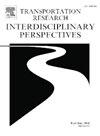How do crime and neighborhood environment affect transit ridership? Evidence from five metropolitan cities in the Texas Triangle
IF 3.9
Q2 TRANSPORTATION
Transportation Research Interdisciplinary Perspectives
Pub Date : 2025-01-01
DOI:10.1016/j.trip.2024.101311
引用次数: 0
Abstract
Transit ridership is an important factor in evaluating transit service performance and an essential source of revenue for transit authorities in the United States. Alongside internal service characteristics such as average headways and service frequency, the neighborhood environment context of transit-adjacent areas has been shown to affect ridership in many ways, with neighborhood crime being a major concern. Although literature recognizes the negative impact of crime on transit ridership, however, the roles of the neighborhood environment and the quality of transit service in affecting ridership have been less considered. Existing empirical evidence has been focused on a single geographical region. Using stop-level transit ridership and service characteristics data from transit agencies in five metropolitan areas in the Texas Triangle (Austin, Dallas, Fort Worth, Houston, and San Antonio) in 2018, we find that although the crime rate is negatively associated with ridership, better transit service characteristics such as higher service frequency and shorter average headway are associated with higher ridership, based on results of the negative binomial regression model. We also find that mixed-use development with greater population density, greater employment density, and employment entropy, as well as better walkability, are associated with higher transit ridership during workdays, holding all else constant. Our findings also show that block groups with challenging socioeconomic status (measured by households of lower income, households with public assistance, and unemployment status), are associated with higher transit ridership. Findings from this study contribute to strategies for sustainable fiscal health of transit agencies. Efforts to increase transit ridership should consider the built environment and social environment characteristics of the station-adjacent communities beyond service characteristics improvement.
求助全文
约1分钟内获得全文
求助全文
来源期刊

Transportation Research Interdisciplinary Perspectives
Engineering-Automotive Engineering
CiteScore
12.90
自引率
0.00%
发文量
185
审稿时长
22 weeks
 求助内容:
求助内容: 应助结果提醒方式:
应助结果提醒方式:


